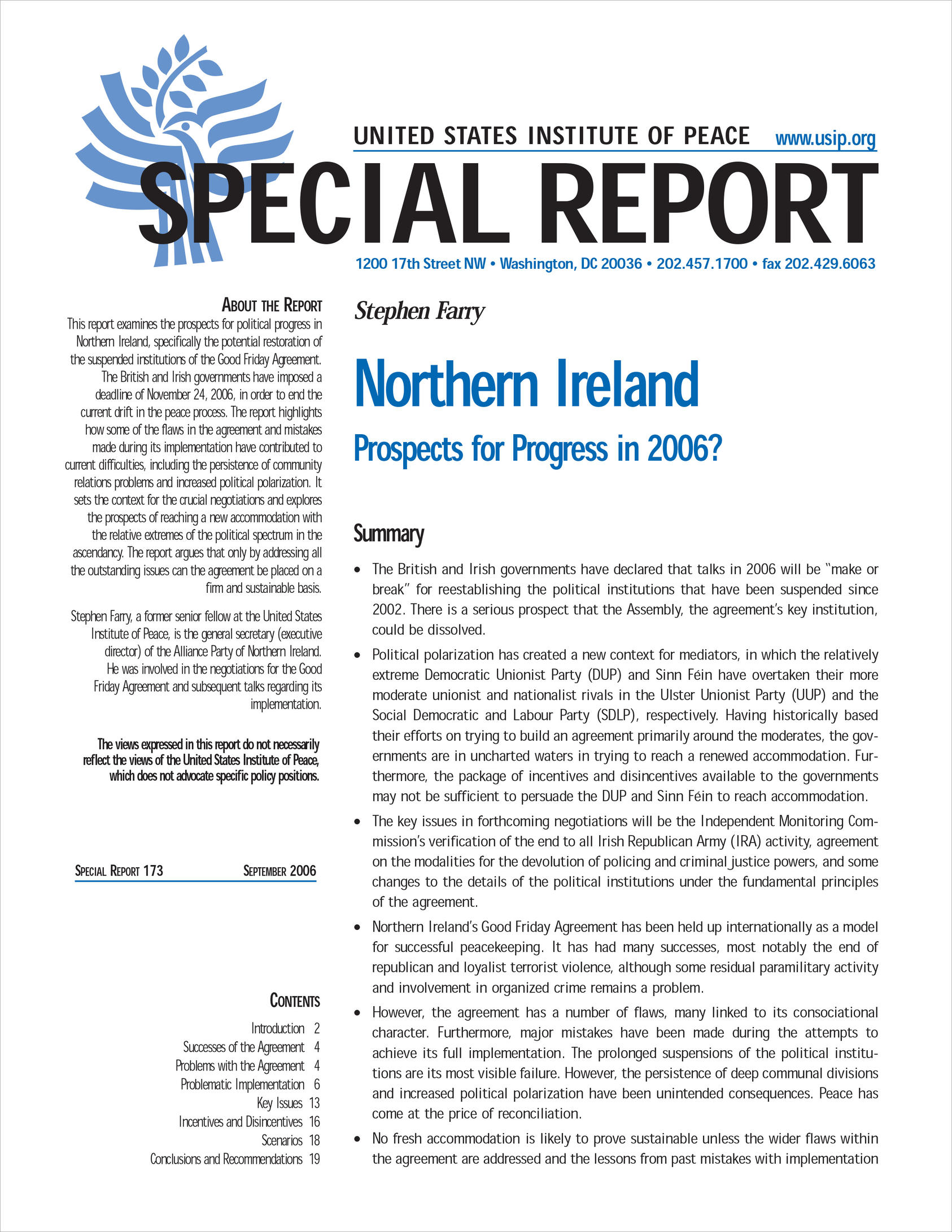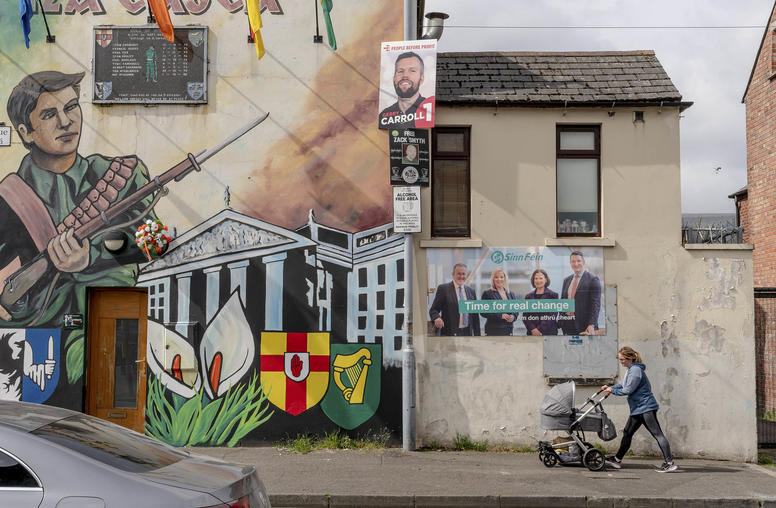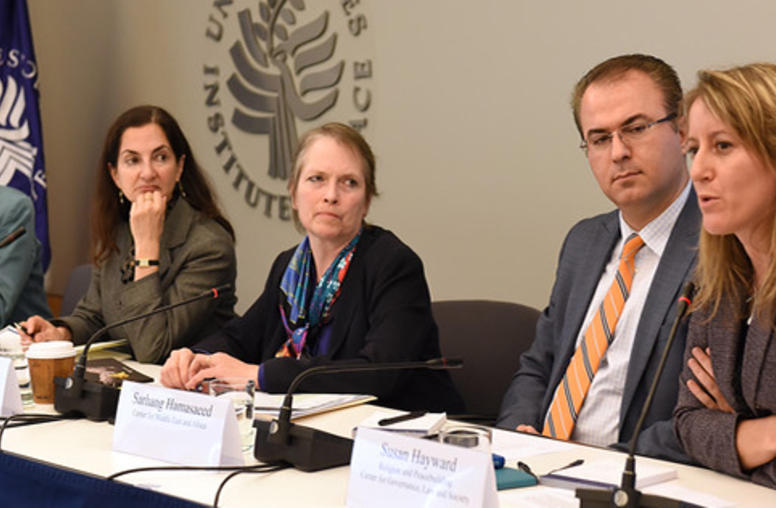Northern Ireland: Prospects for Progress in 2006?
Northern Ireland's Good Friday Agreement has been held up internationally as a model for successful peacekeeping. However, its flaws, specifically those made in attempt to achieve its full implementation, have contributed to the current difficulties in the peace process.

Summary
- The British and Irish governments have declared that talks in 2006 will be "make or break" for reestablishing the political institutions that have been suspended since 2002. There is a serious prospect that the Assembly, the agreement's key institution, could be dissolved.
- Political polarization has created a new context for mediators, in which the relatively extreme Democratic Unionist Party (DUP) and Sinn Féin have overtaken their more moderate unionist and nationalist rivals in the Ulster Unionist Party (UUP) and the Social Democratic and Labour Party (SDLP), respectively. Having historically based their efforts on trying to build an agreement primarily around the moderates, the governments are in uncharted waters in trying to reach a renewed accommodation. Furthermore, the package of incentives and disincentives available to the governments may not be sufficient to persuade the DUP and Sinn Féin to reach accommodation.
- The key issues in forthcoming negotiations will be the Independent Monitoring Commission's verification of the end to all Irish Republican Army (IRA) activity, agreement on the modalities for the devolution of policing and criminal justice powers, and some changes to the details of the political institutions under the fundamental principles of the agreement.
- Northern Ireland's Good Friday Agreement has been held up internationally as a model for successful peacekeeping. It has had many successes, most notably the end of republican and loyalist terrorist violence, although some residual paramilitary activity and involvement in organized crime remains a problem.
- However, the agreement has a number of flaws, many linked to its consociational character. Furthermore, major mistakes have been made during the attempts to achieve its full implementation. The prolonged suspensions of the political institutions are its most visible failure. However, the persistence of deep communal divisions and increased political polarization have been unintended consequences. Peace has come at the price of reconciliation.
- No fresh accommodation is likely to prove sustainable unless the wider flaws within the agreement are addressed and the lessons from past mistakes with implementation are learned. The British and Irish governments, with the close support and advice of the Bush administration, must avoid the temptation to seek another "quick fix."
- If negotiations fail this fall, a return to mass terrorism is unlikely, and the region will remain superficially "normal" in many respects, but Northern Ireland risks emerging as a dysfunctional political entity.
Introduction
The Belfast Agreement, better known as the Good Friday Agreement, was concluded in April 1998 amid great fanfare and expectations for the future. It was a milestone in the troubled history of Ireland. For the first time, the two sovereign governments of the United Kingdom and the Republic of Ireland, with the support of the United States, along with parties from across the political divide, agreed on a new political framework for Northern Ireland. Yet, eight years on from the creation of the Belfast Agreement, Northern Ireland remains in the grip of political uncertainty.
Implementation of the agreement has proved to be much more difficult than its supporters anticipated. Moreover, flaws in the original conception and design of the agreement have been exposed. Its political institutions have been active for less than half the time since the agreement's creation. They have been suspended since October 2002, when the then-leading unionist party, the Ulster Unionists (UUP), made known its unwillingness to sustain the Executive after an alleged IRA spy ring directed against the British government and a number of political parties was uncovered.
The agreement and the way it was implemented have contributed to a deepening of the divisions within Northern Ireland and to an increased political polarization, and in turn these unintended side effects have contributed to the current political deadlock. Insofar as Northern Ireland can be described as peaceful, that peace has come at the price of reconciliation.
Both the British and Irish governments entered 2006 wanting to bring to an end the drift that had entered the peace process. Most Northern Ireland-based parties shared this concern. By November 24, 2006, either power-sharing devolved government will have resumed, or the Assembly, the principal institution arising out of the agreement, will have been dissolved.
However, the November timetable is somewhat artificial in that it is shaped in part by external calculations of the British and Irish governments. British Prime Minister Tony Blair has promised to leave office sometime during his third term and would regard a settlement in Northern Ireland as part of his legacy. A general election is expected in the Republic of Ireland during 2007; Sinn Féin will likely see significant gains and be in a position to influence the shape of the new government.
If the talks fail, the governments will move to a so-far ill-defined Plan B, under which they would try to implement other, noninstitutional aspects of the Good Friday Agreement. Notably, the British government would continue to exercise direct rule over Northern Ireland, but with an enhanced consultative role for the Irish government.
In May 2006, an interim Assembly was put in place without being given any formal power, in order to attempt to elect a power-sharing Executive before the end of November. Technically, this Assembly is not the body provided for in the Good Friday Agreement. Rather, it is a special Assembly, controlled by the secretary of state, which those representatives elected to the Northern Ireland Assembly in November 2003 were invited to attend.
The procedural attempts in the Assembly to determine a new Executive are merely a backdrop to the main negotiations that will occur between the British and Irish governments, periodically involving Tony Blair and Irish Taoiseach (Prime Minister) Bertie Ahern, supported by the Bush administration and the local parties. These negotiations will intensify during the autumn and likely will include a number of major set-piece summits, building up to the putative deadline.
Embedded in the negotiations will be essentially two different elements. The first relates to the ongoing efforts to restore the institutions that were suspended in October 2002. Doing so requires sufficient confidence-building measures from republicans, and commitments from other parties, notably the unionists, to allow the restoration of political institutions. The second element relates to the review of the workings of the institutions provided for in the agreement, which started formally in January 2004. A range of reforms to the structures of the agreement is possible. The DUP is eager to see a number of changes in the institutions. In part, the party wants to make them more effective, but a greater concern is to ensure sufficient changes for the DUP to rationalize to its supporters the switch from being outright opponents to accepting and working under a revised agreement. Others, such as the Alliance Party, have identified deeper structural problems in the agreement.
Since 2004, both the British and Irish governments have accepted that changes can be made to the details of the agreement provided the fundamental principles and institutional framework remain in place. However, the governments may be tempted to try to limit reforms to those deemed necessary to ensure that the DUP is prepared to buy into the institutions. Interestingly, according to the Northern Ireland Life and Times Survey 2005, only 22 percent of those surveyed believed the agreement as it stood was workable, with 41 percent believing that the fundamentals were sound but the specifics needed to be renegotiated, leaving only 23 percent supporting more radical action (www.ark.ac.uk/nilt/2005/Political_Attitudes/index.html).
The immediate causes of suspension seem to have been addressed. In July 2005, the IRA issued a statement that effectively renounced the use of violence for any and all purposes, not just terrorist attacks or other actions to advance the political cause of republicans. In September, the IRA decommissioned virtually all its weapons under the verification of the Independent International Commission on Decommissioning. The Independent Monitoring Commission (IMC) is tasked with assessing this new commitment. Since last summer, the IMC has produced progressively more positive reports, while still expressing concerns on a number of points, such as the involvement of IRA members in organized crime. By October 2006, the IMC is expected to determine that the IRA is in more or less full compliance with its new commitments.
However, a simple restoration of the status quo ante is not a viable option, because there has been a major change in the balance of power within the putative Assembly since October 2002. The DUP and Sinn Féin, the parties on the extremes of the Northern Ireland political spectrum, overtook their respective unionist and nationalist rivals, the UUP and the SDLP, in the 2003 Assembly elections, which proceeded even though the body was in suspension.
There are major question marks over whether the DUP and Sinn Féin, as the new larger parties on either side of the communal divide, are capable of reaching sufficient agreement to restore the institutions, let alone sustain them on a stable basis. This report sets the context for the crucial negotiations during the fall of 2006 and explores the prospects for reaching a new accommodation with the relative extremes of the political spectrum in the ascendancy.
Any comprehensive strategy for such talks must acknowledge and understand the design flaws within the agreement itself, and the mistakes and problems that have occurred during its implementation over the past eight years. Any efforts to restore devolution and to place it on a stable and sustainable basis must be widened beyond immediate efforts to get the DUP and Sinn Féin to achieve the lowest common denominator of agreement on a new accommodation.
While, in the event of failure, there is no real prospect of a return to large-scale terrorism, and Northern Ireland as a society will be able to continue to function with an air of normality, there is considerable danger that Northern Ireland will become a politically dysfunctional entity.
Conclusions and Recommendations
This report has sought to place an analysis of the prospects for political progress in Northern Ireland during 2006 ahead to the November deadline imposed by the British and Irish governments in the wider context of an examination of the flaws and deficiencies in the Good Friday Agreement itself and the mistakes that have been made during its implementation.
A tremendous amount of positive change and progress has occurred in Northern Ireland over the past decade. However, the political institutions have had a difficult existence, and the agreement has not only done little to address wider community relations in Northern Ireland but has directly contributed to political polarization. This changed political context has made the task of building a fair and durable settlement much more difficult, but far from impossible.
The governments and parties need to take a realistic look at what has worked and what has not. The United States should use its influence to push for a sufficiently comprehensive approach to maximize the chances of success. The temptation of a quick fix that leaves some issues unaddressed must be resisted.
Three broad themes should be in the minds of policymakers in trying to formulate a resumption of the institutions of the suspended agreement:
First, it should be clear that the agreement as originally formulated did not work as intended, and probably cannot. Changes to the details and structures of the agreement are essential. Second, it is important to learn the lessons of the problematic attempts to ensure the full implementation of the agreement. Third, it is necessary to take on board the implications of the change in the political balance of power within both unionism and nationalism.
A number of specific steps are also required:
- The British, Irish, and U.S. governments need to maintain pressure on the republican movement to end all paramilitary and criminal activity and support the police service. Also, more pressure needs to be applied to loyalist paramilitaries to decommission their weapons and to give up all violent and criminal activity.
- The governments need to create a negotiating framework that is fully inclusive of the five main political parties, DUP, UUP, Sinn Féin, SDLP, and Alliance, and avoid focusing excessively on the two largest parties, DUP and Sinn Féin.
- The governments need to give much greater consideration not merely to how the DUP and Sinn Féin can agree to form a government together, but how such arrangements can be sustained. The temptation to permit the creation of separate spheres of influence within any DUP-Sinn Féin accommodation must be countered.
- The governments should seriously push an agenda of institutional change. This should include addressing Assembly designations and the nature of the power-sharing Executive. Arguably, changes in the latter are necessary to provide an appropriate setting for the devolution of policing and justice powers.
- Increased efforts must be made to promote a common regional identity for Northern Ireland and to create a sense of a shared vision and destiny. Some consideration should be given to identifying agreed constitutional status, rather than the present polarized choice.
- The governments, with the support of political parties and civil society, must actively pursue and develop the Shared Future agenda, through changing policies and practices in order to build a united community. This is vital to underpin any progress in restoring the political institutions.
- A serious effort must be made to address the interests of victims through a holistic approach to truth, reconciliation, and justice. At the very minimum, a victims' forum should be created.
November 2006 may prove to be a watershed in the Northern Ireland peace process. By international standards, the conflict, while traumatic internally, was not that severe. The communal divisions, while deep, were always fairly narrow. Today, post-agreement, the gaps between the positions of the parties are even smaller. However, faltering progress reflects Sigmund Freud's "narcissism of minor differences." Furthermore, the price of failure for many is tolerable. In the event of collapse, Northern Ireland will continue to stagger on with an air of normality, with the British and Irish governments providing a "soft landing."
The approach taken over the next few months, and the decisions made by the governments and parties, will go a long way to determining how Northern Ireland will be governed and how a number of structural problems within society can be tackled. The Northern Ireland peace process has benefited from enormous attention and goodwill. The opportunity for progress remains, but it must not be squandered.
About the Report
This report examines the prospects for political progress in Northern Ireland, specifically the potential restoration of the suspended institutions of the Good Friday Agreement. The British and Irish governments have imposed a deadline of November 24, 2006, in order to end the current drift in the peace process. The report highlights how some of the flaws in the agreement and mistakes made during its implementation have contributed to current difficulties, including the persistence of community relations problems and increased political polarization. It sets the context for the crucial negotiations and explores the prospects of reaching a new accommodation with the relative extremes of the political spectrum in the ascendancy. The report argues that only by addressing all the outstanding issues can the agreement be placed on a firm and sustainable basis.
Stephen Farry, a former senior fellow at the United States Institute of Peace, is the general secretary (executive director) of the Alliance Party of Northern Ireland. He was involved in the negotiations for the Good Friday Agreement and subsequent talks regarding its implementation.



